4
SUPER SIDE IT WITH GRAINS!
Because whole grains give the best complements.

Making an incredible meal is easy when you’re armed with the tastiest side dishes. Think of these recipes as light meals, too, depending on your appetite. Or combine two—or more—for a colorful culinary adventure on your plate!

Fabulous Freekeh Patties with Five-Star Sauce
Super-Quick Quinoa and Black Bean Sliders
Italian Wheatballs with Variations
Quinoa and Cornmeal–Crusted Fried Green Tomatoes
Mexican Buckwheat and Corn Rounds
Dirty Rice Bites with Mango Salsa
Harissa Veggies and Rice Skillet
Tahini-Topped Kamut and Brussels Sprouts
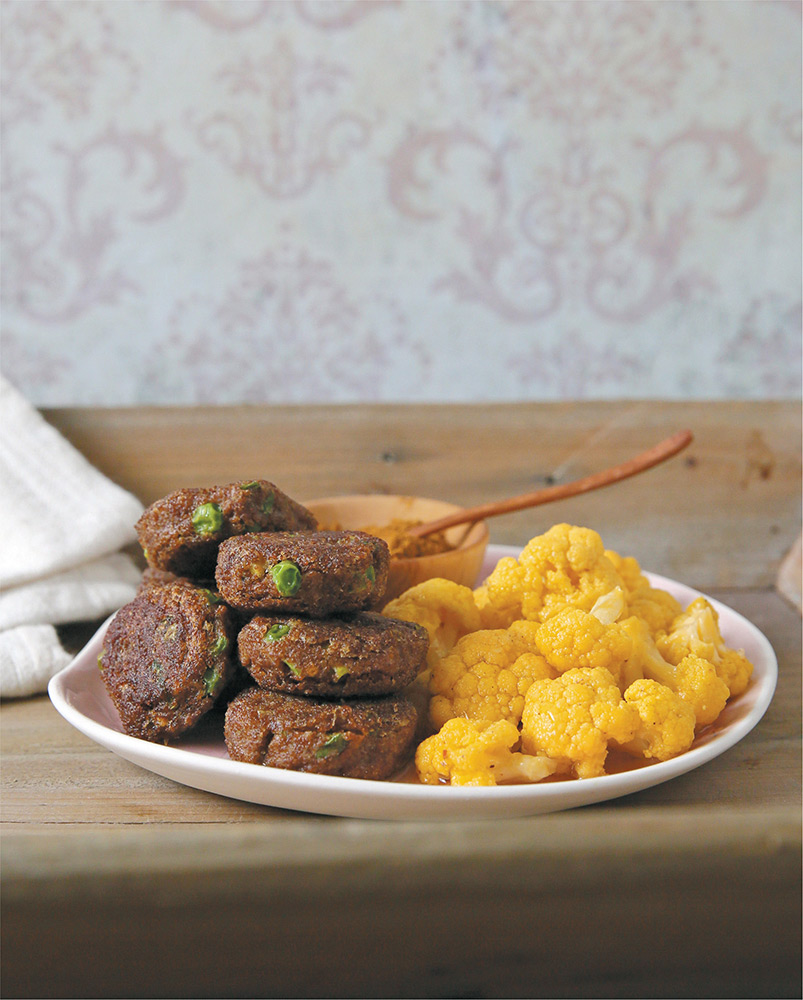
◁ Teff and Pea Fritters
▸ GRAIN: TEFF ▸ SOY-FREE POTENTIAL
We like to cook teff so that the texture of the grain is still somewhat present—like in these cute fritters that are crispy outside and tender inside. If your spice blend is a bit on the hot side, use slightly less. You can always boost the flavor with an extra pinch once cooked.
1/2 cup (100 g) dry teff
1 cup plus 6 tablespoons (325 ml) water, divided
2 1/2 teaspoons (13 ml) fresh lemon juice
1 teaspoon grapeseed or olive oil
2 1/2 tablespoons (15 g) minced scallion
1 large clove garlic, grated or pressed
2 tablespoons (4 g) packed minced fresh mint
1 1/8 teaspoons ras el hanout (see page 53) or berbere spice (see page 16), plus extra for sprinkling
1 teaspoon Broth Powder (page 167)
3/8 teaspoon coarse kosher salt, to taste
1/4 cup (34 g) frozen peas, thawed and drained
6 tablespoons (45 g) chickpea flour
1 tablespoon (8 g) whole-wheat pastry flour (or gluten-free flour blend to give these gluten-free potential)
High heat neutral-flavored oil, as needed
Combine teff with 1 cup (235 ml) water in a saucepan. Bring to a boil, cover with a lid, and lower the heat. Simmer until the liquid is absorbed, about 10 minutes. You’re looking for a pilaflike texture, thus the lower grain-to-water ratio. Set aside to cool slightly.
In a large bowl, stir to combine the cooked teff with lemon juice, oil, scallion, garlic, mint, spice blend, broth powder, salt, and gently fold the peas into the mixture. In a separate small bowl, whisk to combine the remaining 6 tablespoons (90 ml) water with the chickpea flour. Make sure there are no lumps. Gently fold the chickpea mixture and whole-wheat flour into the teff mixture. Do not taste at this point; chickpea flour is bitter when uncooked. Refrigerate for 1 hour before use.
Shape the fritters using 1 packed tablespoon (22 g) of mixture and flattening into a disk of about 2 inches (5 cm) in diameter. Place on a piece of parchment paper while you shape the rest. You should get approximately 22 fritters in all. In a large skillet, heat a very thin layer of oil on medium-high heat. Lower the heat to medium, and cook the fritters in batches, about 3 minutes per side or until browned and crisp. Sprinkle each fritter with a tiny pinch of ras el hanout or berbere spice. Serve immediately with salad or vegetable of choice.
YIELD: 22 fritters
Fabulous Freekeh Patties with Five-Star Sauce
▸ GRAIN: CRACKED FREEKEH
Burgers are a go-to in Tami’s house, and these have been voted the best of the best. We always keep them in the freezer for ultrafast meals. We like to serve them with all the traditional burger fixings—don’t forget the pickles! Some of our testers thought they should be served as steaks, perhaps with a sauce (see opposite page). They are that good!
FOR THE BURGERS:
2 cups (288 g) vital wheat gluten
1 cup (231 g) cooked cracked freekeh
1 tablespoon plus 1 teaspoon (10 g) garlic powder
1 tablespoon plus 1 teaspoon (10 g) onion powder
1 teaspoon ground cumin
1 teaspoon paprika
1/2 teaspoon ground black pepper
1 cup (235 ml) vegetable broth
2 tablespoons (30 ml) tamari
2 tablespoons (33 g) organic ketchup
1 tablespoon (15 ml) olive oil
1 teaspoon liquid smoke
Neutral-flavored oil, for cooking
FOR THE COOKING BROTH:
3 cups (705 ml) vegetable broth
1 tablespoon (15 ml) tamari
1 tablespoon (16 g) organic ketchup
1/2 teaspoon liquid smoke
Salt and black pepper
Preheat the oven to 300°F (150°C, or gas mark 2).
Stir together the vital wheat gluten, freekeh, garlic powder, onion powder, cumin, paprika, and black pepper in a medium-size bowl. Stir together the broth, tamari, ketchup, olive oil, and liquid smoke in a measuring cup. Combine the wet ingredients into the dry ingredients and stir. Add an additional tablespoon of broth (15 ml) or vital wheat gluten (9 g), if needed, to form a cohesive dough. Knead for a few minutes, then divide into 8 equal portions, about 3.7 ounces (105 g) each. Using your hands and a Silpat, pat the burgers out to about 3 inches (7.5 cm) across, and 1/2-inch (1.3 cm) thick. You may need to pinch parts of the burger together to “patch” them.
Heat a thin layer of neutral-flavored oil in large skillet over medium-high heat. Cook the burgers in batches for 3 to 5 minutes until browned. Turn and cook the second side for 3 to 4 minutes until browned.
Stir together the cooking-broth ingredients in a large roasting pan. Put the burgers into the broth. Cover the pan tightly with foil and bake for 1 hour. Turn off the heat and leave the burgers in the oven for 1 hour longer. Let cool in any remaining broth. The burgers can be wrapped airtight and frozen for up to 3 months or refrigerated for up to 3 days. Burgers should be cooled completely before serving for the best texture and, if frozen, should be thawed.
Heat a thin layer of oil in a large skillet over medium-high heat. Cook for 3 to 6 minutes until browned and crisp. Turn over to cook the second side, then serve on buns with toppings of choice.
YIELD: 8 burgers
Five-Star Sauce
When our testers were reviewing the patties, some thought that they were too good to be served as burgers—and that led Tami to feature them with this delectable sauce. Yes, I just said delectable. Upon first taste, Jim declared it to be “five star!” To dress up the patties a bit more (after all, we made a sauce just for them) we dredged them in seasoned flour (about 1 tablespoon [8 g] per 2 patties) before panfrying as usual.
1 large shallot, (about 2.5 ounces, or 70 g), peeled, chopped into 1-inch (2.5 cm) pieces
2 cloves garlic, peeled, sliced lengthwise
2 tablespoons (30 ml) olive oil
Salt and pepper
1 3/4 cups (415 ml) vegetable broth, divided
1/4 teaspoon dried berbere, more to taste
1/4 teaspoon dried thyme, crumbled
2 tablespoons (16 g) cornstarch
2 teaspoons (10 ml) ume plum vinegar
Preheat the oven to 400°F (200°C, or gas mark 6).
Combine the shallot, garlic, and olive oil in a small baking dish. Stir to coat the vegetables, then season with salt and pepper. Bake for 18 to 20 minutes until just turning golden. Transfer to a blender and add 1 1/2 cups (355 ml) broth. Process until smooth.
Heat a medium-size saucepan over medium-low heat. Toast the berbere for 4 to 6 minutes, stirring often, until fragrant. Add the blended broth mixture and the thyme. Bring to a boil over high heat, then reduce to simmer for 5 minutes. Whisk the cornstarch into the remaining 1/4 cup (60 ml) broth. Then whisk the cornstarch/broth into the hot broth mixture. Continue to simmer and whisk until thickened, 3 to 5 minutes. Whisk in the vinegar, then season to taste with salt and pepper.
YIELD: 1 3/4 cups (415 ml)
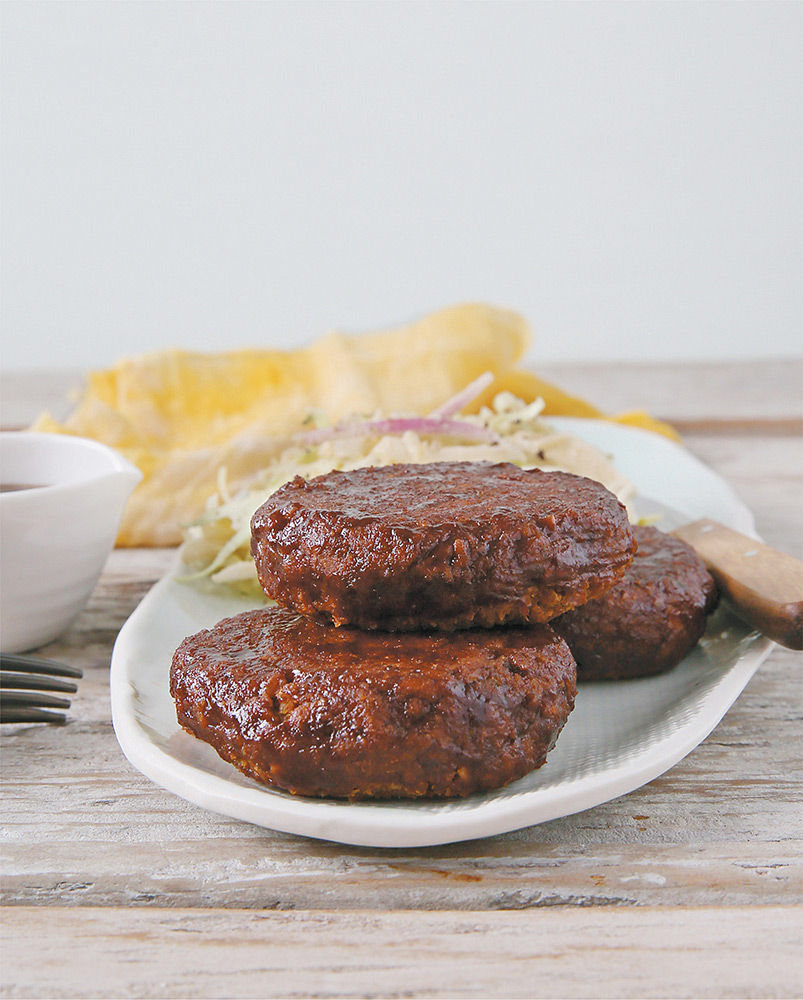
◁ BBQ Bulgur Burgers
▸ GRAIN: BULGUR
Even though these awesome wheat-based burgers aren’t held together by vital wheat gluten, they still manage to come out sturdy and firm enough to be eaten on a bun. Hooray for bulgur and beans! Be picky with the barbecue sauce here, as it is the star of the show in this recipe—aside from bulgur and beans, of course.
1/2 cup (80 g) dry quick-cooking bulgur wheat
1 cup (235 ml) vegetable broth
1 can (15 ounces, or 425 g) chickpeas, drained and rinsed
1/2 cup (120 ml) favorite vegan barbecue sauce, plus extra for serving
2 tablespoons (15 g) nutritional yeast
1/2 teaspoon ground cumin
1/2 teaspoon smoked or regular paprika
1/2 cup (80 g) minced red onion
2 tablespoons (20 g) minced garlic
1/2 cup (40 g) whole-wheat or regular panko bread crumbs
Nonstick cooking spray or oil spray, for baking
Place the bulgur in a rice cooker or medium pot. Cover with broth and stir to combine. Follow the manufacturer’s instructions if using a rice cooker. Bring to a boil if cooking on the stove. Cover with a lid, lower the temperature, and simmer until tender, 12 to 15 minutes. Remove from the heat and let stand 5 minutes still covered, then fluff and let cool before use.
Place the chickpeas, barbecue sauce, nutritional yeast, cumin, paprika, onion, and garlic in a food processor. Pulse to break the chickpeas: You’re not looking for a paste, but there should be no whole chickpea left. Remove approximately half of this mixture and place in a large bowl. Set aside. Add the panko to the food processor. Process until a paste forms. Transfer this mixture and the bulgur to the large bowl, and thoroughly combine. Divide into 8 equal portions of approximately 1/3 cup (100 g), or for smaller burgers, 10 portions of 1/4 cup (80 g). Shape into patties of a generous 3 inches (8 cm) in diameter. Place on a large baking sheet lined with parchment paper. Cover with plastic wrap. Store in the refrigerator for at least 30 minutes, or overnight.
Preheat the oven to 375°F (190°C, or gas mark 5). Remove the plastic wrap. Lightly coat each burger with cooking spray and bake for 20 minutes. Carefully flip, and bake for another 10 minutes or until firm. Let stand 5 minutes before serving with extra barbecue sauce.
YIELD: 8 to 10 burgers
Super-Quick Quinoa and Black Bean Sliders
▸ GRAIN: QUINOA ▸ SOY-FREE POTENTIAL ▸ QUICK AND EASY
Leftovers never tasted better than they do in these sliders. Just because we call them sliders, don’t let that limit your imagination. They are wonderful on salads or eaten like fritters with salsa for dipping. Be sure to brown them well to make them addictively crispy on the outside.
1 cup (172 g) prepared black beans
2 cups (340 g) Corn-oa (page 116)
2 tablespoons (30 ml) prepared barbecue sauce
1/3 cup (38 g) all-purpose flour, more if needed
Neutral-flavored oil, for cooking
Buns, lettuce, tomato slices, bell pepper rings, pickles, other condiments of choice
Put the black beans in a medium-size bowl. With your hands (or a potato masher) mash the beans until mostly pasty. Some of the beans are fine if left whole. Stir in the Corn-oa and barbecue sauce until combined. Add the flour and stir well. Using a 1/4 cup (60 ml) measure, scoop a measuring cup of the mixture. Pat and press it into a patty about 1/2-inch (1.3 cm) thick. The mixture should hold together firmly. If not, return the mixture to the bowl and add an additional tablespoon (8 g) flour and mix again.
Heat a thin layer of oil in a large skillet over medium-high heat. Cook the sliders in batches until browned and crisp, 4 to 5 minutes. Turn them over to cook the second side for 3 to 5 minutes or until browned and crisp.
YIELD: 8 sliders
Pepper Grain Sausages
▸ GRAIN: TRITICALE BERRIES ▸ SOY-FREE POTENTIAL
You must have a taste of these outstanding sausages in Einkorn Paella (page 41) or Muhammara Redux with Sorghum (page 71)! They’re also great eaten as a snack, in salads, or even sandwiches. Be sure to grill or brown them to bring out the full flavor and elevate the texture of the sausages. If you cannot find triticale berries, use the same weight of cooked spelt berries, kamut, or wheat berries.
1 heaping cup (190 g) cooked triticale berries
Scant 6 ounces (1 generous cup, or 165 g) fire-roasted bell pepper
1/4 cup (30 g) nutritional yeast
2 tablespoons (32 g) tahini paste
2 tablespoons (30 ml) fresh lemon juice
1/2 cup (120 ml) water, divided
2 teaspoons (10 ml) grapeseed or olive oil
2 teaspoons (5 g) ground cumin
2 teaspoons (5 g) Broth Powder (page 167)
2 teaspoons (6 g) garlic powder
2 teaspoons (5 g) onion powder
2 teaspoons (4 g) smoked paprika
1 generous teaspoon coarse kosher salt
1 cup (144 g) vital wheat gluten
Place triticale berries, peppers, nutritional yeast, tahini, lemon juice, 1/4 cup (60 ml) water, oil, cumin, broth, garlic and onion powders, paprika, and salt in a food processor. Process until partially smooth: It’s okay if the grains are still visible. Transfer to a large bowl and add the gluten on top. Stir with a spoon, then switch to stirring with one hand, making sure to squeeze the mixture to thoroughly combine. Add an extra 1 tablespoon (15 ml) water or (8 g) gluten, if needed, to make a soft, workable dough.
Divide the mixture evenly (about 3 ounces, or 90 g each) between eight 12-inch (30.5 cm) pieces of foil. Form into sausages of about 7 inches (18 cm) long. Roll the foil tightly around the mixture, twisting the ends to enclose the sausages. Prepare a steamer. Cover and steam the sausages for 1 hour 15 minutes. Remove foil (careful of the steam) and let cool on a wire rack.
The sausages taste best when they spend a whole night in the refrigerator before serving. They must be cooked until slightly browned. Cook on the grill or in a (lightly greased or dry) pan on medium-low heat for approximately 10 minutes, making sure to roll the sausage to brown all over. Store tightly wrapped in the refrigerator for up to 1 week or freeze for up to 2 months.
YIELD: 8 sausages (7 inches, or 18 cm)
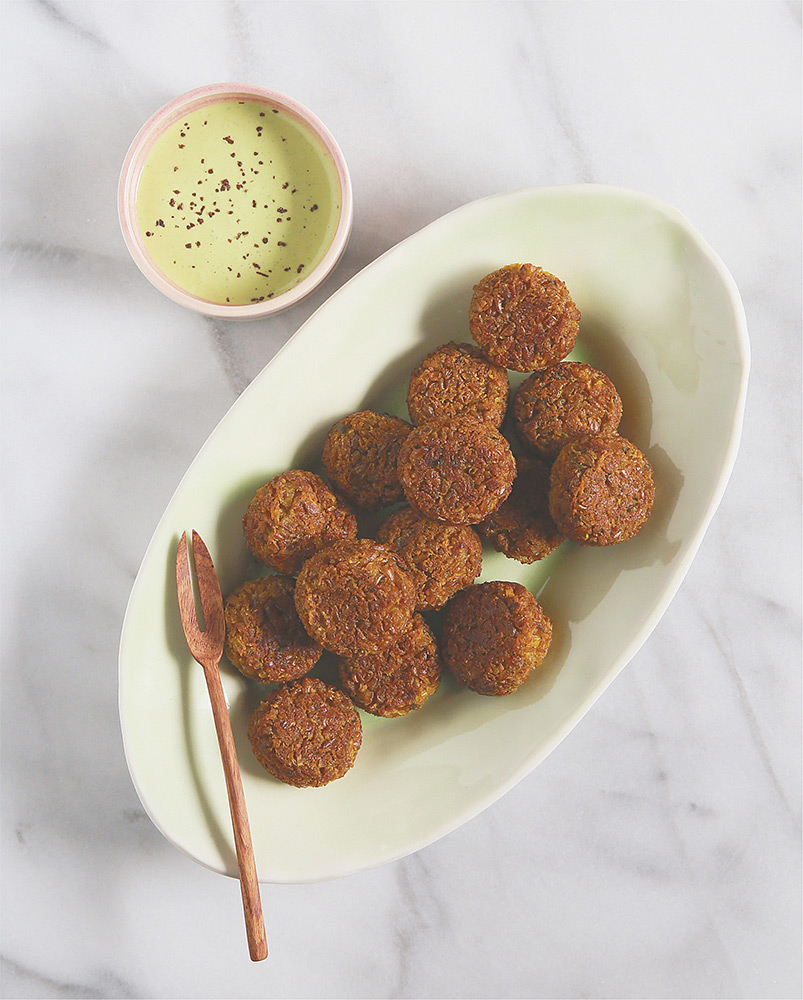
◁ Cracked Wheat Koftas
▸ GRAIN: CRACKED WHEAT ▸ SOY-FREE POTENTIAL
We love finger foods, and these slightly yellow-hued, spicy wheatballs have an awesome texture that no one can resist! Make a quick dipping sauce by thoroughly combining 1/2 cup (120 g) Basic Cashew Cream (page 166) or unsweetened plain vegan yogurt with 1 tablespoon (30 g) of your favorite vegan chutney.
1 cup (160 g) dry cracked wheat
3 cups (705 ml) vegetable broth
1 cup plus 3 tablespoons (130 g) finely grated carrot (about 2)
5 tablespoons (50 g) minced shallot
Generous 1 1/2 tablespoons (15 g) minced garlic
1 teaspoon garam masala
1 teaspoon packed and slightly heaping grated fresh ginger
1 teaspoon dried cilantro or 2 tablespoons (2 g) minced fresh cilantro leaves
1/2 teaspoon ground coriander
1/2 teaspoon turmeric
1/8 to 1/4 teaspoon cayenne pepper, to taste
1/2 teaspoon fine sea salt
1 tablespoon (15 ml) fresh lemon juice
1 tablespoon (15 ml) grapeseed or olive oil
1/4 cup (30 g) chickpea flour
Nonstick cooking spray or oil spray
Place the cracked wheat and broth in a rice cooker or large pot. Stir to combine. Follow the manufacturer’s instructions if using a rice cooker. Bring to a boil if cooking on the stove. Cover with a lid, lower the temperature, and simmer until the grain is tender, about 15 minutes. Drain, if needed, and let cool to room temperature before use.
In a large bowl, stir to combine the cooled wheat, carrot, shallot, garlic, garam masala, ginger, cilantro, coriander, turmeric, cayenne pepper, salt, lemon juice, and oil. Sprinkle the flour on top. Stir with a spoon at first, switching to using one hand to thoroughly combine. Lightly coat 30 cups out of two mini muffin tins with cooking spray. Grab 1 packed tablespoon (25 g) of mixture, roll into a ball between the palms of your hands, and place in the prepared tins. Refrigerate uncovered for 1 hour.
Preheat the oven to 375°F (190°C, or gas mark 5). Lightly coat the top of the koftas with cooking spray before baking for 25 minutes. Gently flip the slightly fragile koftas. Bake for another 5 minutes. Let stand 10 minutes before serving.
YIELD: 30 koftas
Italian Wheatballs
▸ GRAIN: BULGUR
Years ago, Tami’s friend, Lisa Coulson (a.k.a. Panda with Cookie), wrote a zine filled with ballz recipes. With a handful of variations, this recipe is a mini homage to her. Thanks, Lisa, for the tasty inspiration. The bulgur-and-gluten combo forms a solid base for the wheatballs. Try these versions, at right, or create your own. Go wild!
1 cup (200 g) bulgur (Bob’s Red Mill or Arrowhead Mills)
1 cup (144 g) vital wheat gluten
1/2 cup (80 g) very finely minced onion
2 teaspoons (3 g) Italian seasoning blend
2 teaspoons (5 g) garlic powder
1/4 teaspoon red pepper flakes
2/3 cup (160 ml) vegetable broth
2 tablespoons (33 g) organic ketchup
1 tablespoon (15 ml) tamari
1/2 teaspoon fine sea salt
1/4 teaspoon ground black pepper
Olive oil cooking spray
Preheat the oven to 375°F (190°C, or gas mark 5). Lightly oil a baking sheet with the olive oil cooking spray, or use a Silpat.
Combine the bulgur through the red pepper flakes in a medium-size bowl. Combine the remaining ingredients in a measuring cup. Pour the wet ingredients into the dry and knead a few minutes. The mixture should be cohesive and hold together. Scoop 1 tablespoon (23 g) of the mixture and shape into a ball. Place the ball on the prepared baking sheet. Continue until all of the mixture is formed into 20 to 24 balls. Bake for 20 minutes. Turn over to bake 20 minutes longer, then reduce the heat to 300°F (150 °C, or gas mark 2) and bake for 15 minutes. Up to this point, the wheatballs may be made ahead and refrigerated airtight for 2 days or frozen for 2 months.
For serving, the wheatballs must be cooked in liquid. For spaghetti sauce with wheatballs, bring your favorite sauce to a simmer. Add the balls and simmer for 30 minutes, stirring gently and occasionally. The wheatballs may also be cooked in broth in the same manner, drained, and used as desired. Try them as an appetizer on toothpicks with marinara sauce for dipping.
YIELD: 20 to 24 wheatballs
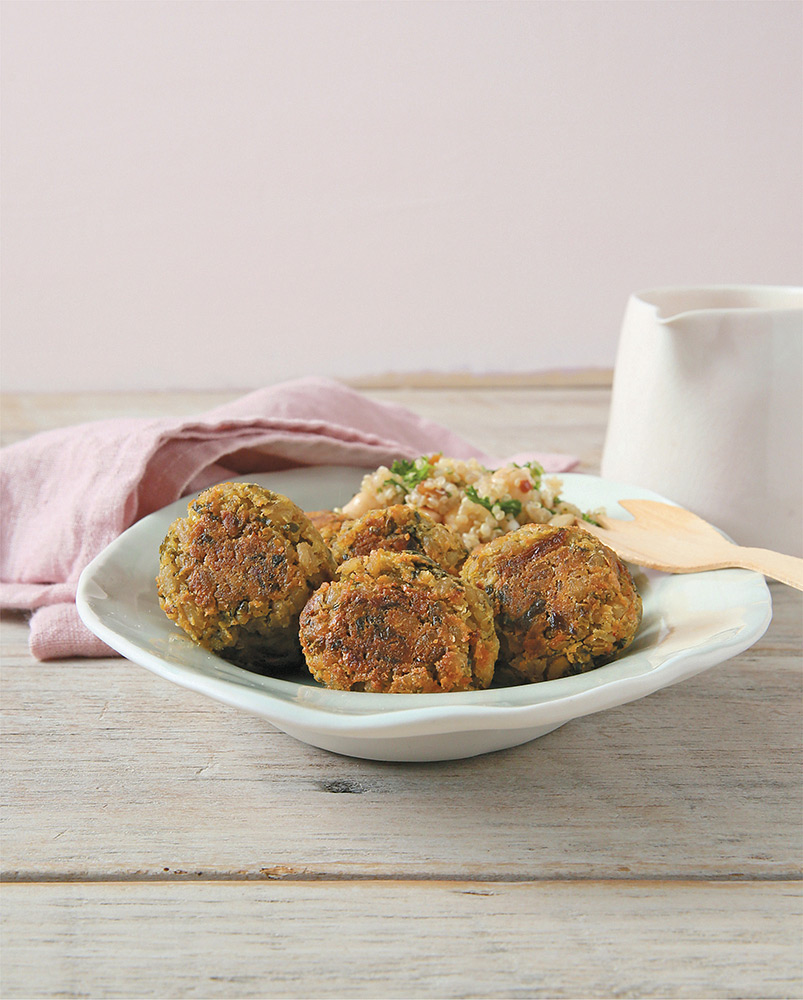
◁ Zhoug Farro Falafel
▸ GRAIN: FARRO ▸ SOY-FREE POTENTIAL
Zhoug is a Yemeni spicy herb paste made with hot peppers, fresh herbs, cumin, and more. It works so well combined with these falafel ingredients! If you fear heat, switch to using only 1 small jalapeño pepper (0.9 ounce, or 25 g) instead. See the Recipe Note for a dip suggestion.
1 cup (165 g) cooked farro or (194 g) spelt berries
1 cup (164 g) cooked chickpeas
2 small jalapeño peppers (1.75 ounces, or 50 g), trimmed and seeded
1/4 cup (6 g) packed fresh cilantro leaves
1/4 cup (15 g) packed fresh flat-leaf parsley
1 tablespoon (10 g) minced garlic
1/2 teaspoon coarse kosher salt
1/2 teaspoon ground cumin
1/4 teaspoon ground black pepper, to taste
1/8 teaspoon ground cardamom or 1/4 teaspoon ground allspice
2 tablespoons (30 ml) grapeseed or olive oil
1 tablespoon (15 ml) fresh lemon juice
1/4 cup (40 g) minced red onion or (20 g) scallion
6 tablespoons (45 g) chickpea flour
1/4 teaspoon baking powder
Nonstick cooking spray or oil spray
In a food processor, place the farro and chickpeas. Process until the mixture is partially smooth: It’s okay to have chunky pieces of beans, but none should remain whole. Transfer to a medium bowl.
To the food processor, add the peppers, cilantro, parsley, garlic, salt, cumin, black pepper, cardamom, oil, and lemon juice. Process until smooth, stopping to scrape the sides with a rubber spatula, if needed. Transfer to the same bowl and stir to combine. Sprinkle the flour and baking powder on top, folding gently to thoroughly combine. Cover with a lid, and refrigerate for 1 hour, up to overnight.
Preheat the oven to 375°F (190°C, or gas mark 5). Lightly coat a mini muffin tin with cooking spray. Grab 1 packed, slightly heaping tablespoon (24 g) of mixture, and place in the prepared tin. Bake for 15 minutes. Gently flip with a small baker’s spatula and press down slightly with spatula. Bake for another 10 to 15 minutes until firm and golden brown. Let stand 10 minutes before serving.
YIELD: 20 to 24 falafel
Millet Amaranth Croquettes
▸ GRAINS: MILLET AND AMARANTH
We’ve kept the flavor of these tasty croquettes neutral enough so that they can be combined with any favorite vegan dipping sauce. Check out the recipe directions for serving suggestions.
1/2 cup (110 g) dry millet, rinsed and drained
1/4 cup (45 g) dry amaranth
1 1/2 cups (355 ml) vegetable broth
1/2 fire-roasted bell pepper (2 ounces, or 56 g), minced, drained, and patted dry
4 cloves garlic, grated
2 tablespoons (30 ml) fresh lemon juice
2 tablespoons (32 g) tahini paste
2 tablespoons (15 g) nutritional yeast
2 tablespoons (36 g) light miso
2 tablespoons (24 g) potato starch or (16 g) organic cornstarch
1/4 teaspoon fine sea salt
2 tablespoons (7 g) minced parsley
1/4 cup (30 g) whole-wheat pastry flour, plus extra if needed, or gluten-free flour mix
Nonstick cooking spray or oil spray
Place the millet and amaranth in a rice cooker or large pot. Cover with broth, stir to combine. Follow the manufacturer’s instructions if using a rice cooker. Bring to a boil if cooking on the stove. Cover with a lid, lower the temperature, and simmer until the liquid is absorbed, about 15 minutes.
In the meantime, mix the remaining ingredients (except flour) in a large bowl, then add the millet and amaranth, stirring to thoroughly combine. Cover loosely and chill in the refrigerator at least 2 hours up to overnight.
Preheat the oven to 375°F (190°C, or gas mark 5). Stir the flour into the mixture. Note that it will be moist. However, if it’s more liquid than moist, add up to 1/4 cup (60 g) extra flour, 1 tablespoon (8 g) at a time until it becomes more manageable. Coat a mini muffin tin with cooking spray. Scoop 1 packed, barely heaping tablespoon (30 g) of the mix, and drop into the tin. You should get 24 croquettes in all. Lightly coat the tops with cooking spray and gently even out the tops with your fingers. Bake for 20 minutes and gently flip with a small spatula. Bake for another 10 minutes or until golden brown but not dry. Let stand 10 minutes before serving with your favorite vegan marinara, barbecue sauce, or other dipping sauce. Leftover Slightly Cheesy Cashew Sauce (page 166), it would be perfect as well.
YIELD: 24 croquettes
Cajun Buckwheat Rice Fries
▸ GRAIN: BUCKWHEAT GROATS ▸ GLUTEN-FREE POTENTIAL ▸ SOY-FREE POTENTIAL
These crispy fries beg to be dipped in flavored ketchup! For one person, combine 3 tablespoons (51 g) organic ketchup, hot sauce to taste, and a few pinches of Cajun seasoning, if desired. If you cannot locate brown rice farina, you can make your own using a hand grain grinder or coffee grinder. You could also use whole-wheat farina (won’t have gluten-free potential in this case) or millet farina in its place.
1/2 cup (90 g) dry buckwheat groats
1/2 cup (82 g) brown rice farina
1 tablespoon (8 g) nutritional yeast
1 1/2 tablespoons (12 g) Broth Powder (page 167)
1 teaspoon onion powder
Generous 1/2 teaspoon garlic powder
1/2 teaspoon fine sea salt
2 cups (470 ml) water
Nonstick cooking spray or oil spray
Place buckwheat in 4 batches of 2 tablespoons (23 g) in coffee grinder or miniblender, pulsing to break down into small bits but not flour (about 6 short-burst grinds). Transfer to a medium pot. Add the farina, nutritional yeast, broth powder, Cajun seasoning, onion and garlic powders, and salt. Whisk with water. Bring to a gentle boil on medium-high heat, whisking constantly. Lower the heat to a low simmer and cook 2 minutes, whisking constantly. Cover and cook for 6 minutes, removing the lid occasionally to stir. Adjust the heat, if needed, to prevent scorching. When the mixture is too thick for whisking, switch to a rubber spatula. Remove the lid, and keep cooking until very thick (like dry mashed potatoes), about 4 minutes.
Spread evenly in an 8-inch (20 cm) square baking pan coated with cooking spray, using an angled spatula. Do not cover the pan. Cool at room temperature. Cover with plastic wrap and chill for at least 2 hours or overnight.
Preheat the oven to 425°F (220°C, or gas mark 7). Lightly grease a large-rimmed baking sheet with cooking spray. Remove from pan, cut into four 4-inch (10 cm) squares. Cut each square into 5 or 6 fries, for a total of 20 to 24 fries.
Lightly coat with cooking spray, and space evenly on prepared sheet. Bake for 15 minutes and flip. Bake for another 10 to 15 minutes or until browned and crisp. Serve with flavored or plain ketchup.
YIELD: 4 servings
Tacu Tacu
▸ GRAIN: BROWN RICE ▸ GLUTEN-FREE POTENTIAL ▸ SOY-FREE POTENTIAL ▸ QUICK AND EASY
Tacu tacu, or bean and rice fritters, are a Peruvian mainstay. They were initially brought to Peru by way of the African slaves. With the crispy outside and almost creamy inside, it’s easy to see why the dish quickly rose in popularity. Plus, who can resist saying it? Tami first heard about it from her Peruvian friend, Monica, to whom she says gracias!
1/2 cup (120 g) prepared salsa (spicy is good here!)
1/2 cup (120 ml) water, plus enough to make 1 3/4 cups (415 ml) liquid (or according to package)
1 cup (180 g) dry short-grain brown rice
2 tablespoons (30 ml) olive oil, divided
1/2 cup (80 g) finely minced onion
1 can (15 ounces, or 425 g) butter beans, drained
2 cloves garlic, minced
2 teaspoons (5 g) ground cumin
1/2 teaspoon smoked paprika
1/2 teaspoon fine sea salt
1/3 cup (80 ml) vegetable broth
Black pepper
Blend the salsa with 1/2 cup (120 ml) of water until smooth. Add enough water for a total of 1 3/4 cups (415 ml) of liquid, or the amount the rice package requires for 1 cup (180 g) of dry rice. Cook according to package directions and let cool.
Heat 1 tablespoon (15 ml) of oil in a large skillet over medium heat. Add the onion, beans, garlic, cumin, paprika, salt, and broth. Cook, while smashing the beans, to create a refried bean consistency. This should take 5 to 7 minutes. Season to taste with pepper. Remove from the heat and stir in the rice. Once cool enough to handle, the mixture should be shapeable. Using 1/2 cup (5 ounces, 140 g) of the mixture, form into a football-shaped pancake that is a generous 1-inch (2.5 cm) thick.
Heat the remaining tablespoon (15 ml) of olive oil in a large, nonstick skillet over medium-high heat. Cook the mixture, continuing to shape and pack it with a metal spatula until browned, 4 to 6 minutes. Turn over to cook the second side until browned, 3 to 5 minutes. Serve hot.
YIELD: 6 servings
Aztec Tofu
▸ GRAIN: AMARANTH ▸ GLUTEN-FREE POTENTIAL
The crispy coating gives way to a slightly spicy full-flavor tofu that is a refreshing change of pace from most everyday tofu recipes. We like to serve it with the Corn-oa (page 116), but it pairs well with rice, too. Heads up! This tofu is best marinated for at least 24 hours, so plan ahead.
FOR THE TOFU AND MARINADE:
1 pound (454 g) extra-firm tofu, drained and pressed, cut into 1/4-inch (6 mm) slices
1/4 cup (60 ml) vegetable broth
1/4 cup (60 ml) dry red wine, or additional broth
1 tablespoon (15 ml) tamari
1 teaspoon chili powder
1 teaspoon ground cumin
1 teaspoon garlic powder
1 teaspoon onion powder
1/2 teaspoon fine sea salt
FOR THE BREADING AND COOKING:
3/4 cup (180 ml) plain, unsweetened vegan milk
1/3 cup plus 1 tablespoon (71 g) amaranth
2 tablespoons (33 g) organic ketchup
1 teaspoon chili powder
1 cup (160 g) corn flour, (not cornmeal) divided
Salt and pepper
Neutral-flavored oil, for cooking
To make the tofu and marinade: Whisk the broth, tamari, and seasonings together in a 9 × 13-inch (23 cm × 33 cm) pan. Put the tofu in the marinade and turn to coat. Cover with plastic wrap and refrigerate for 24 hours or up to 3 days.
To make the breading: Whisk the milk, amaranth, ketchup, and chili powder together in a shallow dish. Whisk in 3/4 cup (120 g) of the corn flour. Season with salt and pepper. Put the remaining corn flour on a plate.
Heat a thin layer of oil in a large skillet over medium-high heat. Dredge the tofu in the corn flour, then in the batter. Place the tofu in the skillet. The batter will slightly spread from the tofu. Cook for 3 to 5 minutes until the batter that has spread is browned. Gently turn the tofu over. Turning the tofu over too soon will cause the breading to stick to the pan, not the tofu. Cook the tofu on the second side until browned, 3 to 5 minutes. Cook the remaining tofu in batches, if necessary.
YIELD: 4 to 6 servings
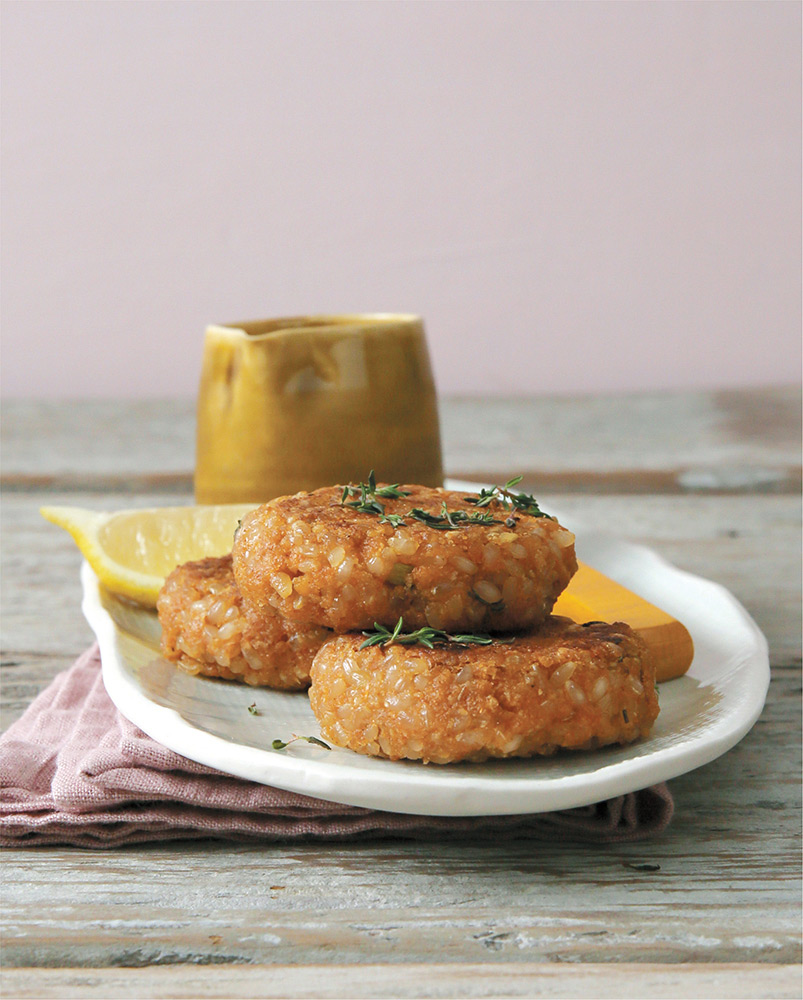
◁ Cajun Rice Patties
▸ GRAIN: SWEET BROWN RICE ▸ SOY-FREE POTENTIAL
These crispy rice patties are even more delightful drizzled with hot sauce or sprinkled with extra Cajun seasoning. Serve with a lightly dressed crisp lettuce or sliced, summery, heirloom tomatoes.
1/2 cup (98 g) dry sweet brown rice, rinsed and drained
2 cups (470 ml) vegetable broth
3 tablespoons (18 g) minced scallion
2 cloves garlic, minced
1 1/2 teaspoons Cajun seasoning (choose a salt-free blend, such as Frontier), plus extra for garnish
1 1/4 teaspoons fresh thyme leaves, minced
Generous 1/2 teaspoon coarse kosher salt, to taste
1/2 to 1 teaspoon hot sauce (such as Frank’s), to taste
1/2 teaspoon mild Dijon mustard
1/3 cup (65 g) cooked white beans (choose moist beans), mashed
3/4 cup (60 g) vegan panko bread crumbs, as needed
High heat neutral-flavored oil, as needed
Lemon wedges, to serve
Combine the rice and broth in a pot. Bring to a boil, lower the heat, and cover with a lid. Simmer until tender, about 30 to 35 minutes. Drain if needed. Set aside to cool slightly.
Transfer the rice to a large bowl and stir the scallion, garlic, Cajun seasoning, thyme, salt, hot sauce, and mustard to combine. Add the beans and thoroughly stir to combine. Add 1/2 cup (40 g) of bread crumbs to begin with. The total amount needed will depend on how moist the beans are. The mixture should be quite thick and just moist enough without being sticky or too dry. Cover and place in the refrigerator for 1 hour.
Have a piece of parchment paper handy or shape the patties as you go. Use 1/4 cup (57 g) of mixture per patty and shape into generous 3-inch (8 cm) disks. Place on the parchment.
Heat a thin layer of oil in a large skillet. Cook the patties in batches on medium heat, 6 minutes per side or until golden brown and crispy. You want to cook them long enough so that they get a crispy coating and not-too-moist inside. Adjust the heat as needed. Serve with wedges of lemon.
YIELD: 6 to 8 patties
Quinoa and Beer Onion Rings
▸ GRAIN: QUINOA ▸ SOY-FREE POTENTIAL ▸ QUICK AND EASY
These onion rings are both elegant and casual. Imagine two of these atop a seitan steak in a fancy restaurant. And just think: What if you could get these at your local dive bar? This combo makes them perfect any time.
1 cup (185 g) cooked quinoa (We like tri-color, but any is fine)
1/2 cup plus 2 tablespoons (75 g) all-purpose flour (see Recipe Note)
1 teaspoon cornstarch
3/4 teaspoon fine sea salt
1/2 teaspoon garlic powder
1/4 teaspoon dried parsley
1/4 teaspoon ground black pepper
3/4 cup (180 ml) vegan lager or light ale
1 medium onion, sliced into 1/2-inch (1.3 cm) thick rings
High heat neutral-flavored oil, for cooking
Line a baking sheet with a brown bag.
Combine the quinoa, flour, cornstarch, salt, garlic powder, parsley, and black pepper in a pie plate. Stir to combine with a fork. Stir in the beer. The mixture will be thick and a little lumpy. Set aside
Heat approximately 1/2 inch (1.3 cm) of oil in a large skillet over medium to medium-high heat. Dip the onion rings into the batter. Coat them well, but allow any excess to drip off. Cooking in batches, put them in the skillet. Cook for 3 to 5 minutes until golden. Turn over and cook the second side for 3 to 5 minutes or until golden. Transfer to the paper bag to drain while cooking the remaining onion rings.
YIELD: 4 servings
Quinoa and Cornmeal–Crusted Fried Green Tomatoes
▸ GRAIN: CORNMEAL ▸ GLUTEN-FREE POTENTIAL ▸ SOY-FREE POTENTIAL
Beautifully crisp, these fried green tomatoes won’t be like any you have ever had. We’ve carefully layered the flavor in each of the steps so that these pack a tasty punch.
FOR THE SALSA-SPIKED SAUCE:
1/4 cup (35 g) cashews
1/2 cup (120 ml) water
1/2 cup (132 g) prepared salsa
1 tablespoon (15 ml) red wine vinegar
1 tablespoon (15 ml) plain, unsweetened vegan milk
1 chipotle pepper in adobo, optional
Salt and pepper
FOR THE TOMATOES AND SERVING:
1/2 cup (56 g) quinoa flour, divided
1/4 cup (35 g) coarse cornmeal
1/2 teaspoon onion powder
Salt and pepper
1/2 cup (120 ml) plain, unsweetened vegan milk
1 teaspoon red wine vinegar
1 teaspoon hot sauce, optional
2 large green tomatoes, cut into 1/2-inch (1.3 cm) thick slices
2 cups (150 g) chopped cabbage
1/2 cup (82 g) frozen corn kernels, thawed under hot water
1/2 cup (86 g) cooked black beans
1 tablespoon (9 g) minced scallion
High heat neutral-flavored oil, for cooking
To make the sauce: Bring the cashews and water to a boil. Simmer for 15 minutes and drain. Transfer to a small high-powered blender and add the remaining sauce ingredients. Blend until smooth. Refrigerate until needed.
To make the tomatoes: For the dry ingredients, put 1/4 cup (28 g) quinoa flour on two plates. Add the cornmeal and onion powder to one of the plates. Season both plates with salt and pepper.
Whisk the milk, vinegar, and hot sauce together. Set aside.
Heat 1/4 inch (6 mm) of oil in a large skillet over medium-high heat. Working in batches, keeping one hand wet and one hand dry, dredge the tomatoes in the quinoa flour, then the milk mixture, then the cornmeal mixture. Pat to coat the tomatoes well. Cook them in the oil until the tomatoes start to look slightly brown on the bottom edges, 3 to 5 minutes. Gently turn with a fork, away from your body in case of spatters. Cook for 4 to 5 minutes until golden brown. Drain very briefly on a paper towel, if desired.
To serve, spread the cabbage on a platter. Top with the tomatoes and drizzle with the sauce, as desired. Sprinkle evenly with the corn, beans, and scallion. Serve immediately.
YIELD: 8 to 10 green tomato slices, 3/4 cup sauce (180 ml)
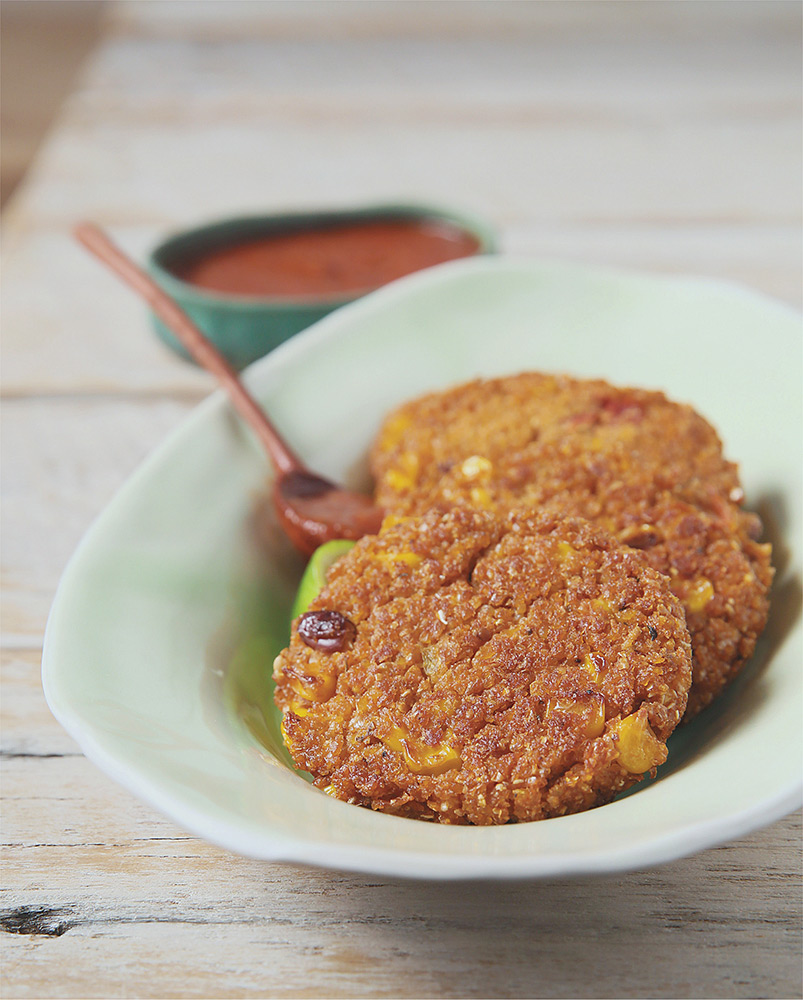
◁ Mexican Buckwheat and Corn Rounds
▸ GRAINS: BUCKWHEAT GROATS AND CORNMEAL ▸ GLUTEN-FREE POTENTIAL ▸ SOY-FREE POTENTIAL
Using a whoopie pie pan guarantees the best-shaped results for these savory whole-grain rounds. If not available, use 3-inch (7.6 cm) pie pans to shape and then transfer the rounds to a baking sheet lined with parchment paper. These can be served with the dressing from the Tex-Mex Freekeh Salad (page 156), but any salsa will do. If you love avocados and a drizzle of lime, they are nice complements, too!
Nonstick cooking spray or oil spray
1/2 cup (90 g) dry buckwheat groats
1/2 cup (86 g) organic medium cornmeal (such as Bob’s Red Mill)
1 1/2 teaspoons mild to medium chili powder
1/2 teaspoon ground cumin
1/2 teaspoon onion powder
1/2 teaspoon fine sea salt, to taste
1/4 teaspoon dried oregano leaves
1/4 teaspoon ground coriander
1/4 teaspoon garlic powder
1/4 teaspoon smoked or regular paprika
2 cups (470 ml) vegetable broth
1/2 cup (82 g) frozen corn kernels
1/4 cup (75 g) vegan salsa (green or red)
Lightly coat a whoopie pie pan with cooking spray. Set aside.
Place groats in 4 batches in coffee grinder or mini blender, pulsing to break down into small bits but not flour (about 6 short-burst grinds). Transfer to a medium pot, with cornmeal, chili powder, cumin, onion, salt, oregano, coriander, garlic, and paprika. Whisk with broth, then add and whisk frozen corn and salsa. Bring to a gentle boil on medium-high heat, whisking occasionally. Reduce the heat to a low simmer, and cover with lid. Cook for 8 minutes, removing the lid occasionally to stir with a rubber spatula. Adjust the heat, if needed, to prevent scorching. Cook and stir another 2 minutes until the mixture is very thick.
Scoop out about 3 packed, slightly heaping tablespoons (65 g) of the mixture into each prepared hole: An ice cream or cookie scoop works well for this. Even out tops, and lightly coat the tops with cooking spray. Let cool at room temperature. Cover with plastic wrap and refrigerate for 2 hours or overnight.
Preheat the oven to 400°F (200°C, or gas mark 6). Remove the plastic wrap. Bake 20 minutes and carefully flip. Bake for another 10 minutes until golden brown. Let stand a few minutes before serving.
Alternatively, these can be panfried in batches in a thin layer of oil in a skillet, on medium-high heat for about 8 minutes on each side until golden brown. Adjust the heat, as needed.
YIELD: 12 3-inch (8 cm) rounds
Home-style Bulgur Gravy
▸ GRAIN: BULGUR ▸ QUICK AND EASY
This gorgeous gravy is sure to become your mashed potatoes’ new bff. Try it on grilled seitan, too. The secret ingredient is teff flour. It brings loads of hearty flavor, especially when you consider the gravy can be made in minutes. One word of caution: It doesn’t store well, so be prepared to eat it all!
2 tablespoons (30 ml) neutral-flavored oil
3 tablespoons (30 g) minced onion
2 tablespoons (16 g) minced carrot
2 tablespoons (30 g) minced celery
1 clove garlic, minced
1 cup (60 g) minced cremini mushrooms
1/2 cup (100 g) cooked bulgur
2 tablespoons (16 g) all-purpose flour
2 tablespoons (20 g) teff flour
1/2 teaspoon ground cumin
Pinch cayenne pepper
3 tablespoons (45 ml) dry white wine
1 cup (235 ml) vegetable broth
1 tablespoon (15 ml) tamari
1/2 teaspoon liquid smoke, or to taste
Salt and pepper
Heat the oil, onion, carrot, and celery in a large skillet over medium heat. Cook, stirring occasionally with a whisk, until the onion is fragrant, 3 to 4 minutes. Add the garlic, mushrooms, and bulgur. Cook for 2 minutes, then add the flours, cumin, and cayenne pepper. Cook, and whisk for 3 to 5 minutes to cook the flour. The mixture will be very clumpy and pasty.
Add the wine to deglaze the pan, whisking to combine the ingredients. Whisk in the broth. Add the tamari and liquid smoke. Continue to whisk and cook until thickened, 3 to 4 minutes. Season to taste with salt and pepper.
YIELD: 1 2/3 cups (466 g)
Presto Pesto Spelt Bites
▸ GRAIN: SPELT ▸ SOY-FREE POTENTIAL ▸ QUICK AND EASY
These flavorful little bites are so easy to make, especially if you have pesto and cooked grain handy. They’re sure to please the finger-food lovers of the household. Be sure to keep some of the pesto to make our Creamy Pesto Asparagus Einkorn (page 56)!
FOR THE PESTO:
2 1/2 cups (60 g) fresh basil leaves
1 1/2 cups (45 g) fresh baby spinach
1 tablespoon (8 g) Broth Powder (page 167)
1 tablespoon (15 ml) fresh lemon juice
1 clove garlic, minced
1/4 teaspoon coarse kosher salt
1/4 cup (60 ml) extra-virgin olive oil
2 tablespoons to 1/4 cup (30 to 60 ml) water, as needed
FOR THE BITES:
Nonstick cooking spray or oil spray
1 cup (200 g) packed cooked spelt berries (or similar grain, like kamut)
1 cup (185 g) cooked cannellini beans
1/4 cup (60 g) pesto, plus extra for serving
1/4 to 1/2 cup (20 to 40 g) whole-wheat panko bread crumbs, as needed
A few grinds black peppercorn
1/2 teaspoon coarse kosher salt
To make the pesto: Place the basil, spinach, broth powder, lemon juice, garlic, and salt in a food processor or blender. Pulse a few times to chop. Slowly drizzle in the oil and add water, as needed, until the mixture is well combined, smooth, and neither too thick nor too thin. Store in an airtight jar in the refrigerator until ready to use for up to 3 days.
To make the bites: Preheat the oven to 350°F (180°C, or gas mark 4). Lightly coat a mini muffin tin with cooking spray.
In a large bowl, mash together the cooked spelt, beans, pesto, pepper, and salt. Stir 1/4 cup (20 g) of bread crumbs into the mixture: It should be easy to form into not-too-dry, not-too-wet ball shapes with the hands. Add the remaining 1/4 cup (20 g), if needed, as the moisture level depends on how tender the beans are. Spoon out 1 packed tablespoon (22 g) of mixture, shape into a ball and place in the prepared tin. Repeat with remaining bites, and lightly coat tops with cooking spray. You should get 24 bites in all, but this number can vary slightly. Bake 15 minutes and flip carefully. Bake for another 10 to 15 minutes until firm. Let stand at least 5 minutes before serving with extra pesto.
YIELD: 22 to 24 bites, 3/4 cup plus 2 tablespoons (210 g) pesto
Dirty Rice Bites with Mango Salsa
▸ GRAIN: BROWN RICE ▸ SOY-FREE POTENTIAL ▸ QUICK AND EASY
Bring on the Bayou! These fritter bites are easy to make and quick to disappear. We’ve paired them with a zesty mango-and-tomato salsa—perfect for dunking!
FOR THE MANGO SALSA:
1/2 cup (80 g) minced fresh mango
1/2 cup (90 g) chopped tomato
1 tablespoon plus 1 teaspoon (13 g) minced shallot
1 teaspoon minced fresh parsley
1/4 seeded, minced jalapeño, or to taste
1 teaspoon balsamic vinegar
Hot sauce
Salt and pepper
FOR THE DIRTY RICE BITES:
1 cup (107 g) Dirty Rice (page 107)
1 cup (182 g) prepared white beans (such as Navy or Great Northern), mashed
1/2 cup (60 g) all-purpose flour
High heat neutral-flavored oil, for cooking
To make the salsa: Combine the mango, tomato, shallot, parsley, jalapeño, and vinegar in a small bowl. Season to taste with the hot sauce, salt, and pepper. Set aside to let the flavors blend. The salsa may be made ahead of time and refrigerated airtight for up to 2 days. If refrigerated, bring the salsa to room temperature before serving.
To make the bites: Combine the rice and mashed beans in a medium-size bowl. Stir together well. Scoop 2 tablespoons (40 g) of the mixture and form into a small round patty, about 2 inches (5 cm) across. Place on a baking sheet. When all the bites are formed, heat a thin layer of oil in a large skillet over medium heat. Working in batches, dredge the bites in the flour, then put in the hot oil. Cook for 4 to 5 minutes until nicely browned. Turn over to cook the second side for 3 to 5 minutes until browned. Continue until all of the bites are cooked. Serve with the salsa.
YIELD: 14 bites, generous 1 cup (160 g) salsa
Dirty Rice
▸ GRAIN: BROWN RICE/WILD RICE BLEND ▸ GLUTEN-FREE POTENTIAL ▸ SOY-FREE POTENTIAL
For flavorful-but-easy meals look no further than the “new” grains that are popping up on store shelves. Here, we’ve enhanced one of our recent finds: a brown and wild rice blend. With the holy trinity of New Orleans cuisine, this one is exceptional beside baked tofu, grilled seitan, or—of course—beans!
1 tablespoon (15 ml) olive oil
1/2 cup (80 g) minced onion
1/4 cup (30 g) minced celery
1/4 cup (30 g) minced green bell pepper
2 cloves garlic, minced
1 teaspoon Cajun spice blend
1 teaspoon dry poultry seasoning
1/4 teaspoon cayenne pepper, optional
1/4 teaspoon dried thyme
1/2 teaspoon salt (see Recipe Note)
1 cup (180 g) wild rice/brown rice blend
2 cups (470 ml) water
Heat the oil in a lidded medium-size saucepan over medium heat. Add the onion, celery, pepper, garlic, spices, salt, and rice. Stir to coat and cook for 3 to 5 minutes, until fragrant. Add the water and bring to a boil. Cover and reduce to simmer. Cook for 35 to 45 minutes until the rice is tender.
YIELD: 4 side servings

◁ Harissa Veggies and Rice Skillet
▸ GRAIN: BROWN RICE ▸ GLUTEN-FREE POTENTIAL ▸ QUICK AND EASY ▸ SOY-FREE POTENTIAL
As it is written, this recipe is quite mild, despite the harissa. You can adjust its quantity to taste for spicier results. This delicious, ready-in-a-snap rice would be perfect served alongside your favorite bean recipe. The benefit of adding beans is that your meal would now be turned into a filling, complete protein, in one fell swoop.
1 tablespoon (15 ml) toasted sesame oil
5 tablespoons (50 g) minced shallot
1 tablespoon (10 g) minced garlic
1 bell pepper (any color), seeded and chopped
Fine sea salt, to taste
1 teaspoon ground cumin
2 teaspoons (4 g) dry harissa blend or paste, to taste
1 tablespoon (15 ml) fresh lemon juice
1 cup (164 g) frozen corn kernels, rinsed to thaw slightly
3/4 cup (188 g) chopped tomato with juice (such as Pomi)
1 tablespoon (8 g) nutritional yeast
2 slightly heaping cups (420 g) cooked and chilled brown rice of choice
Fresh cilantro or parsley leaves, for garnish
Lemon wedges, for garnish
Place the oil, shallot, garlic, and bell pepper in a large skillet. Heat on medium-high and cook, stirring occasionally, until the vegetables just start to soften, about 4 minutes. Add salt to taste, cumin, and harissa. Sauté for another minute. Add the lemon juice and corn, folding to combine. Sauté for another minute. Add the tomatoes, nutritional yeast, and rice. Cook uncovered on medium-low heat for 8 minutes until heated through and to let the flavors meld. Adjust seasoning, if needed. Garnish with fresh herb of choice and lemon wedges.
YIELD: 4 side servings
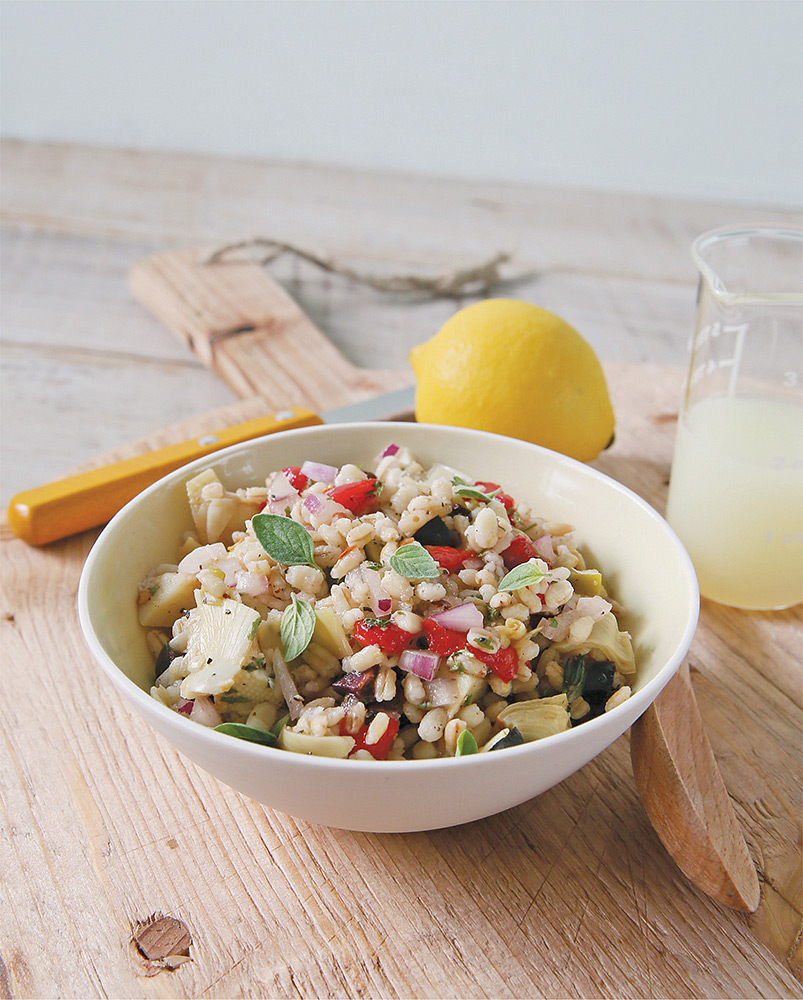
◁ Greek Barley
▸ GRAIN: BARLEY ▸ SOY-FREE POTENTIAL
We vegans love our potlucks! Several testers thought this would be a terrific make-and-take dish. We agree. It’s a customizable recipe, so be sure to add more of your favorites—whether it’s the olives or the artichoke hearts. If we’re lucky enough to have a handful of homegrown cherry tomatoes, we add those, too.
1 cup (157 g) prepared barley, cooled
2 tablespoons (20 g) minced red onion
4 pitted kalamata olives, chopped
2 green olives, chopped
2 tablespoons (23 g) jarred roasted red bell pepper, chopped
1 water-packed artichoke heart, chopped
2 teaspoons (3 g) minced fresh parsley
2 teaspoons (10 ml) fresh lemon juice
1/4 teaspoon dried oregano, crumbled
1/4 teaspoon evaporated cane juice
Salt and pepper
Put the barley, onion, olives, red pepper, artichoke heart, and parsley in a medium-size bowl.
Whisk the lemon juice, oregano, and evaporated cane juice together in a small bowl. Pour over the barley. Let sit 30 minutes for the flavors to meld or cover and refrigerate. Taste and adjust the seasonings before serving.
YIELD: 1 3/4 cups (270 g)
Jasmine Rice Kedgeree
▸ GRAIN: BROWN RICE ▸ GLUTEN-FREE POTENTIAL ▸ SOY-FREE POTENTIAL
Kedgeree is an Anglo-Indian dish that often contains fish. Our version is happily seafood-free here. We’re quite fond of jasmine rice and of its faint floral flavor, but if you prefer brown basmati rice, it will work quite well, too. (Adjust cooking liquid amount and cooking time, if needed.) Because no dish is complete without tons of vegetables, be sure to serve the kedgeree with a generous amount of roasted cauliflower or broccoli!
1 tablespoon (15 ml) grapeseed or olive oil, divided
1 cup (180 g) dry brown jasmine rice, rinsed and drained
1 3/4 cups (415 ml) water
1 yellow onion, peeled and chopped
Generous 1/4 teaspoon smoked or regular fine sea salt, to taste
1/2 teaspoon ground cumin
1/2 teaspoon ground coriander
1/4 teaspoon ground turmeric
1/4 teaspoon garam masala
1/8 teaspoon cayenne pepper, to taste, optional
1 tablespoon (17 g) tomato paste
2 cloves garlic, minced
Splash vegan dry white wine or mirin
1 1/2 cups (201 g) thawed green peas
Combine 1 1/2 teaspoons oil, rice, and water in a large skillet. Bring to a boil, cover, and simmer until the liquid is absorbed, 30 to 35 minutes. Let stand covered away from the heat for 10 minutes, then fluff with a fork.
While the rice cooks, heat the remaining 1 1/2 teaspoons of oil in another large skillet. Add the onion and sauté on medium-high heat until browned, about 8 to 10 minutes, stirring occasionally. Adjust the heat, if needed, to make sure the onion doesn’t burn. Add the salt, cumin, coriander, turmeric, garam masala, cayenne pepper if using, tomato paste, and garlic. Stir quickly just to combine. The skillet will be hot, so add a splash of wine or mirin immediately after stirring to make sure this mixture stays moist and doesn’t burn, then cook 1 minute. Stir the peas into the onion-and-spice mixture. Cook for 1 or 2 minutes just until the peas are heated through. Stir the onion-and-spice mixture into the rice. Serve with roasted vegetables on the side. Leftovers reheat well, so this is a dish that can be prepared ahead of time, if needed. Store cooled leftovers in an airtight container in the refrigerator for up to 4 days.
YIELD: 4 to 6 side servings
Green Beans and Bulgur
▸ GRAIN: BULGUR ▸ SOY-FREE POTENTIAL ▸ QUICK AND EASY
Tender-yet-crunchy green beans make every bite of this bulgur dish delectable. It’s a simple, almost rustic dish, and it is a wonderful side for baked tofu or grilled portobello mushrooms.
1 cup (160 g) dry bulgur
2 cups (470 ml) water
1 tablespoon (15 ml) olive oil
2 cups (240 g) 1-inch (2.5 cm) pieces green beans
1/4 cup (40 g) chopped shallot
4 cloves garlic, minced
1/2 cup (48 g) grated carrots
2 teaspoons (5 g) paprika
1 teaspoon dried Italian seasoning
1 teaspoon dried thyme
1/4 teaspoon dried rosemary
Salt and pepper
Combine the bulgur and water in a medium-size saucepan. Bring to a boil, then reduce the heat to simmer and cover. Cook for 12 to 15 minutes or until tender. If any liquid remains, drain the bulgur. Set aside.
Heat the oil in a large skillet over medium-high heat. Add the green beans and shallot and cook for 2 to 3 minutes until the beans are bright green, but do not overcook. Add the garlic, carrots, paprika, Italian seasoning, and thyme. Cook for 2 minutes longer. Add the bulgur and stir. Cook for 3 to 4 minutes or until heated through and combined. Season to taste with salt and pepper.
YIELD: 6 side servings
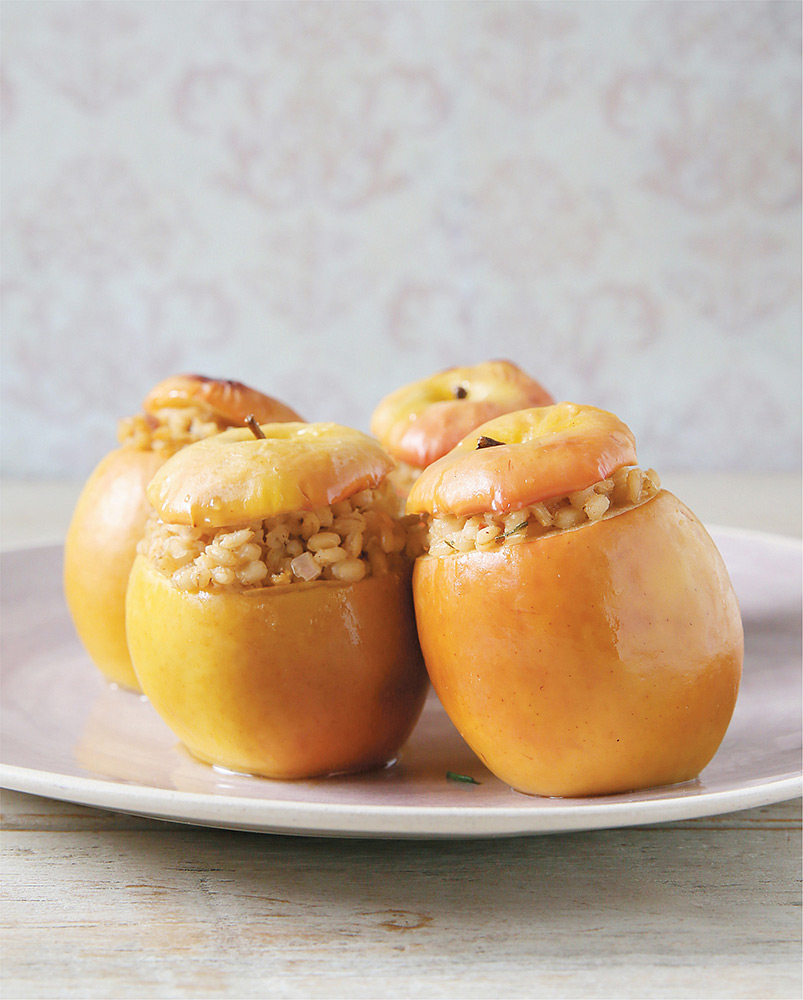
◁ Savory Stuffed Apples
▸ GRAIN: EINKORN
This tasty side dish really struts its stuff beside a seitan cutlet. The baking time will vary depending on both the size and the variety of the apples. Try to choose apples that are similar in size for consistency in baking. As far as the grain goes, barley, farro, or freekeh would be good stand-ins for the einkorn.
1 cup (208 g) dry einkorn
1 tablespoon plus 1 teaspoon (13 g) minced shallot
2 teaspoons (12 g) dark miso (South River Garlic Red Pepper is a favorite)
2 teaspoons (10 ml) seasoned rice vinegar
1 teaspoon tahini paste
1/4 teaspoon minced fresh rosemary, or 1/2 teaspoon dried
Salt and pepper
4 McIntosh, Melrose, or other sturdy baking apples, cored
Prepare the grain according to the chart, page 15. Preheat the oven to 400°F (200°C, or gas mark 6).
Mix together the einkorn, shallot, miso, vinegar, and tahini paste in a medium-size bowl. Season to taste with salt and pepper. Pack the grain mixture evenly into the cored apples, patting any extra on top. Bake for 15 minutes. If the apples are not tender, cover loosely with foil and bake for 15 minutes longer or until the apples are tender. The size of the apples will determine the baking time.
YIELD: 4 servings
Corn-oa
▸ GRAIN: QUINOA ▸ GLUTEN-FREE POTENTIAL ▸ SOY-FREE POTENTIAL
Sure, rice is great for a Mexican-themed dinner, but it’s time to shake it up. While our grain of choice here is very authentic, we’ll admit that the way we use it isn’t. The chipotle is highly recommended, but not absolutely necessary. Leftovers are highly recommended, too, because you will definitely want to make the Super-Quick Quinoa and Black Bean Sliders (page 86).
2 cups (470 ml) water
1/2 to 1 chipotle pepper in adobo
1 tablespoon (15 ml) olive oil
1/2 cup (80 g) minced onion
1/4 cup (38 g) minced green bell peppers
5 cherry tomatoes, cut into quarters
3 to 4 cloves garlic, minced
1 cup (164 g) frozen corn kernels, run under hot water to thaw
1 cup (173 g) dry quinoa
1 teaspoon fine sea salt
1/4 teaspoon ground black pepper
Blend the chipotle with the water in a blender. Set aside.
Heat the oil in a medium-size saucepan over medium heat. Add the onion, pepper, and tomatoes. Cook and stir until softened, 3 to 4 minutes. Stir in the garlic and corn, and cook 2 minutes longer. Stir in the quinoa, salt, pepper, and water. Bring to a boil, cover, and reduce the heat. Simmer for 20 to 25 minutes, or until the tails have popped and the water is absorbed.
YIELD: 4 side servings
Spinach and Basil Quinoa
▸ GRAIN: QUINOA ▸ GLUTEN-FREE POTENTIAL ▸ QUICK AND EASY
The fresh spinach and basil shine in this simple, easy side dish. If you have leftovers, refrigerate them airtight. Check the seasonings when serving the leftovers … as a salad!
2 tablespoons (30 ml) white wine vinegar
1 tablespoon (15 ml) tamari
2 cloves garlic, minced
2 teaspoons (6 g) nutritional yeast
1/2 teaspoon dried thyme
Pinch red pepper flakes, optional
1/2 cup (92 g) dry quinoa
Handful baby spinach, chopped
3 tablespoons (8 g) chopped fresh basil
2 tablespoons (12 g) minced scallion
Salt and pepper
Whisk the vinegar, tamari, garlic, nutritional yeast, thyme, and red pepper flakes together in a small bowl. Set aside.
Cook the quinoa according to the package directions. Drain and return to the saucepan. Stir in the spinach, basil, scallion, and the vinegar mixture. Season to taste with salt and pepper.
YIELD: 4 side servings
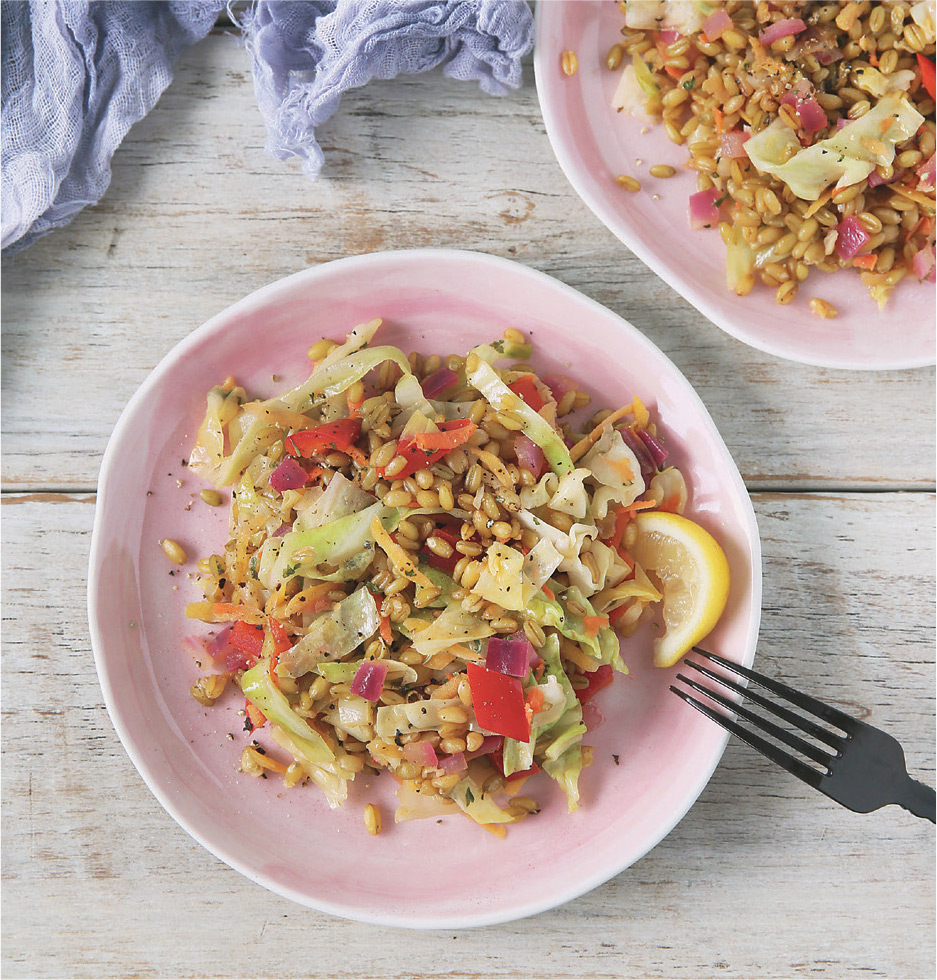
◁ Cabbage Pilaf
▸ GRAIN: FREEKEH ▸ SOY-FREE POTENTIAL ▸ QUICK AND EASY
Crisp vegetables spike the grain of your choice in this quick-to-prepare, fresh-tasting side dish. We opt for freekeh here, but feel free to substitute barley, einkorn, or kamut, if you prefer.
1 tablespoon (15 ml) olive oil
1/2 cup (80 g) chopped onion
1/3 cup (49 g) chopped red bell pepper
2 cups (154 g) chopped cabbage
1/2 cup (56 g) grated carrots
1/2 teaspoon dried herbes de Provence (see Recipe Note)
2 cups (336 g) cooked freekeh
Juice from 1/2 lemon
1 tablespoon (3 g) minced fresh parsley
Salt and pepper
Heat the oil in a large skillet over medium heat. Add the onion, bell pepper, and cabbage. Cook, stirring occasionally, for 4 minutes until soft. Add the carrots, herbes de Provence, and freekeh. Cook, stirring, until heated throughout. Stir in the lemon juice and parsley. Season to taste with salt and pepper.
YIELD: 4 side servings
Tahini-Topped Kamut and Brussels Sprouts
▸ GRAIN: KAMUT ▸ SOY-FREE POTENTIAL
Brussels sprouts are one of our favorites. We just can’t get enough of them. We’re betting you feel the same … so we’re sharing our tangy, tahini-topped version of wilted brussels sprouts enhanced by kamut and za’atar.
FOR THE BOWL BASE:
1 teaspoon olive oil
12 ounces (340 g) brussels sprouts, thinly sliced
Salt and pepper
1 cup (184 g) kamut, cooked, and cooled
3/4 cup (120 g) minced carrot
1/2 cup (76 g) minced onion
Juice of 1 lemon
1 to 2 tablespoons (2 to 4 g) za’atar seasoning
FOR THE DRESSING:
1/2 cup (120 ml) vegetable broth
2 tablespoons to 1/4 cup (30 ml to 60 ml) white wine vinegar
1 tablespoon plus 1 teaspoon (20 g) tahini paste
2 teaspoons (8 g) Dijon mustard
2 teaspoons (10 g) toasted sesame oil
1/2 to 1 teaspoon pure maple syrup
2 cloves garlic
To make the bowl base: Heat the oil in a large skillet over medium-high heat. Add the brussels sprouts and season with salt and pepper. Cook, stirring occasionally, until wilted and some are blackened, 6 to 8 minutes. Transfer to a bowl. When cool, stir in the remaining bowl base ingredients, adding the za’atar to taste.
To make the dressing: Combine all the ingredients in a small high-powered blender. Process until smooth. Pour over the bowl to taste, reserving some of the dressing if not serving immediately. The bowl can be covered and refrigerated for up to 3 days. Add extra dressing to moisten when serving.
YIELD: 4 side servings
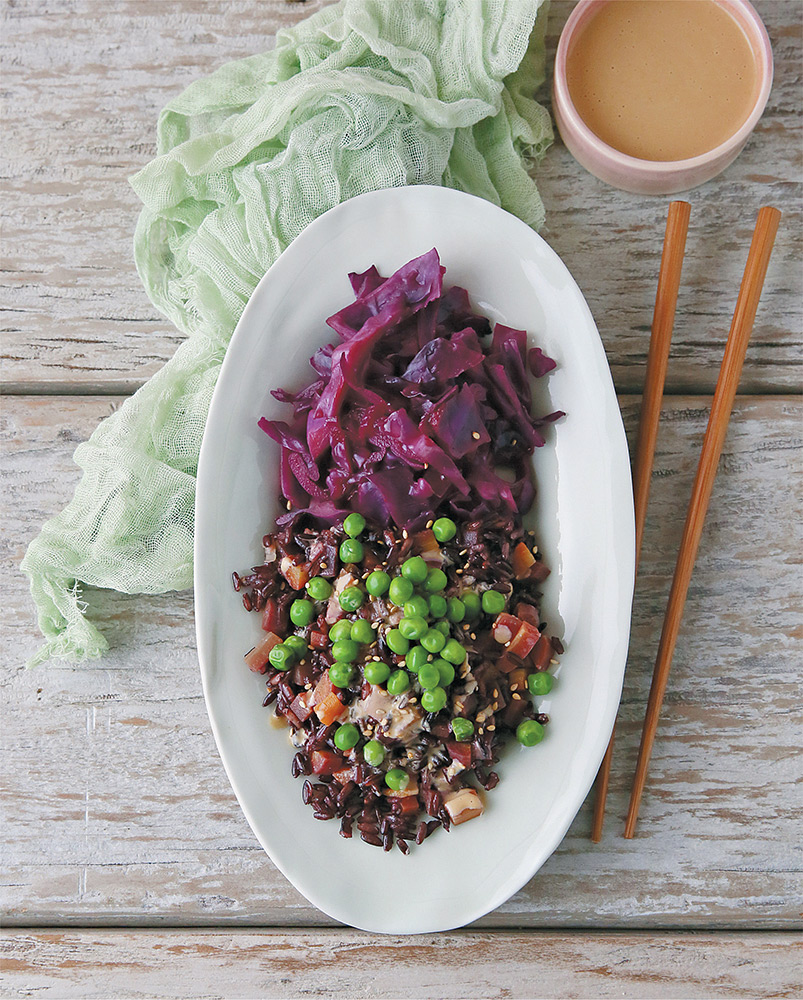
◁ Sesame Purple Rice
▸ GRAIN: BLACK RICE ▸ GLUTEN-FREE POTENTIAL
Black rice cooks into a beautiful, dark-purple hue. We’ve matched it with purple carrots, but any carrot will do. If you cannot find black rice, use wild rice or any brown rice (or a combination of both) instead. Simply change the cooking time and method accordingly. Maca powder is a nutrition-filled dried root, but nutritional yeast can be used in its place if it’s unavailable or cost prohibitive.
1 cup (180 g) dry black rice, rinsed and drained
2 tablespoons (32 g) tahini paste
2 tablespoons (30 ml) water
1 tablespoon (15 ml) seasoned rice vinegar
1 tablespoon (15 ml) fresh lemon juice
1 1/2 teaspoons tamari
1 1/2 teaspoons white miso
1 teaspoon maca powder or nutritional yeast (optional)
Pinch cayenne pepper, to taste, optional
1 teaspoon agave nectar or brown rice syrup
1 1/2 teaspoons toasted sesame oil
9 ounces (about 4, or 255 g) carrots, peeled and thinly sliced into half-moons
1/4 cup (20 g) chopped scallion
1 to 2 cloves garlic, minced
1 cup (134 g) frozen green peas or (155 g) shelled edamame, thawed
Toasted sesame seeds or cashews, for garnish
Place the rice in a medium pot. Cover with an extra 2 inches (5 cm) water. Bring to a boil and cook uncovered on medium heat until al dente, about 25 minutes. Stir occasionally. Drain in a sieve and quickly rinse with cold water. Place the sieve on top of the pot to further drain and cool.
While the rice is cooking, place the tahini, water, vinegar, lemon juice, tamari, miso, maca powder, cayenne pepper if using, and agave in a small bowl. Whisk to thoroughly combine. Set aside.
Place the oil, carrots, and scallion in a large skillet. Cook on medium heat until tender, about 6 to 8 minutes. Add the garlic and cook another minute. Whisk the tahini sauce again. Pour the desired quantity on top of carrots, folding to combine. Fold the cooled rice into the preparation and cook until heated through, about 4 minutes. Add the peas and cook another minute. (Alternatively, you can combine carrots, rice, and peas, and slowly heat the sauce on the side, serving with warm sauce drizzled over each portion for an even prettier outcome.) Garnish with sesame seeds. We love to serve this with cooked-to-crisp green or red cabbage on the side. If you have sauce leftovers, store in an airtight container in the refrigerator for up to 4 days.
YIELD: 4 side servings, 1/2 cup (120 ml) sauce
Easy Cheesy Baked Grits
▸ GRAIN: POLENTA
This hearty dish is a big hit for brunch, but it’s savory enough to be a sensational side for dinner. Grits are sometimes thought to be a bit touchy to cook, but our baked version couldn’t be easier.
Nonstick cooking spray
2 cups (470 ml) plain, unsweetened vegan milk
1 1/2 cups (355 ml) vegetable broth
3/4 cup (107 g) sauerkraut, drained but not squeezed
1/2 cup (70 g) raw cashews
1/3 cup (50 g) minced onion
1/3 cup (40 g) nutritional yeast
1 tablespoon (15 ml) apple cider vinegar
1 tablespoon (18 g) light miso
1 tablespoon (15 ml) olive oil
2 cloves garlic
1 teaspoon Dijon mustard
1 teaspoon fine sea salt
1/2 teaspoon ground white pepper
1 cup (140 g) polenta (grits)
Ground black pepper, to taste
Preheat the oven to 350°F (180°C, or gas mark 4). Lightly spray a 9 × 13-inch (23 × 33 cm) baking dish with cooking spray.
Combine the milk, broth, sauerkraut, cashews, onion, nutritional yeast, vinegar, miso, olive oil, garlic, mustard, salt, and white pepper in a high-powered blender. Process until very smooth. Pour into a medium-size saucepan. Bring to a boil over medium heat. Gently pour the grits into the liquid, whisking continuously. Reduce to a simmer and cook, whisking, for 5 minutes. Taste and adjust the seasonings, adding the black pepper. Pour into the prepared baking dish. Bake for 25 minutes until set. Let cool 5 minutes before serving.
YIELD: 1 (9-inch, or 23 cm) dish
Spiced Einkorn
▸ GRAIN: EINKORN ▸ SOY-FREE POTENTIAL
We all need more extra-easy, yet always pleasing, side dishes in our repertoires. This one is sensational beside baked tofu or some saucy seitan. As all harissa pastes vary, we choose a spicy one here. Cook to your own tastes.
1 tablespoon (15 ml) olive oil
1/4 cup (40 g) minced shallot
1 carrot, peeled and grated
2 teaspoons (10 g) harissa paste, more to taste
1 teaspoon berbere, more to taste
1/2 teaspoon fine sea salt
1 cup (208 g) dry einkorn, or grain of choice
2 teaspoons (10 ml) fresh lemon juice, or to taste
2 cups (470 ml) water
Heat the oil, shallot, carrot, harissa, berbere, and salt in a small, heavy-bottomed pot that also has a lid, over medium heat. Add the grain and stir to coat the grains, cook for 3 to 4 minutes until fragrant. Add the lemon juice and water and bring to a boil, cover, and reduce the heat to simmer. Cook, stirring occasionally, for 35 to 40 minutes or until the grain is tender. Taste and adjust the seasoning.
YIELD: 4 side servings
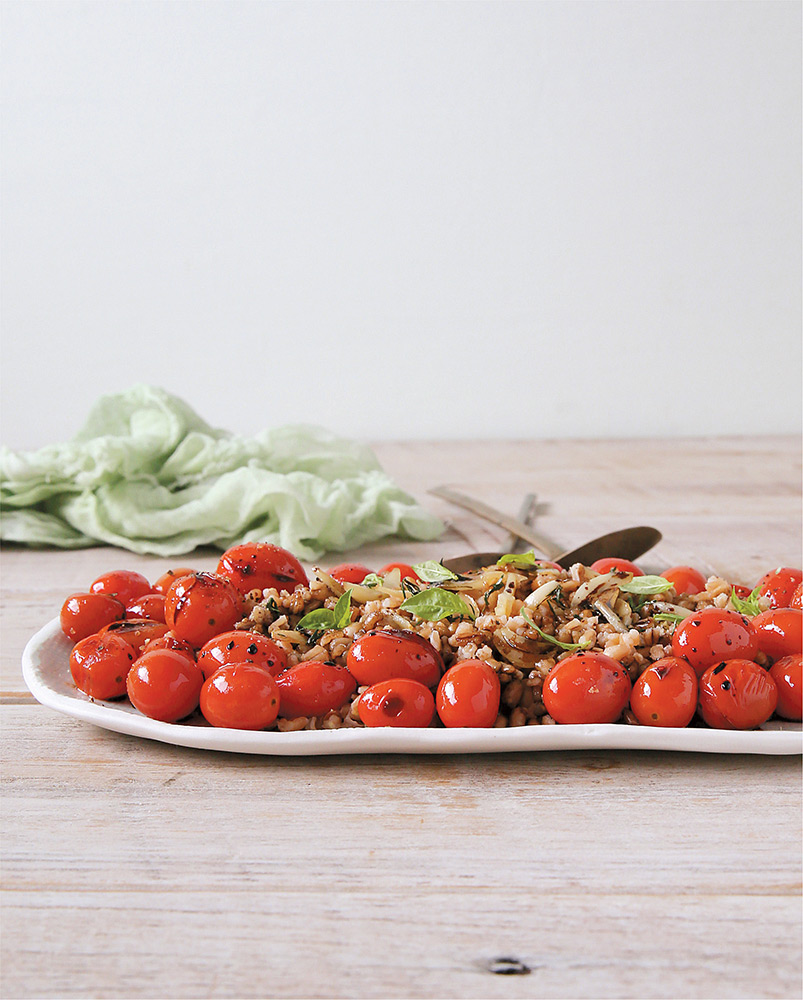
◁ Burst Tomato Farro
▸ GRAIN: FARRO ▸ SOY-FREE POTENTIAL ▸ QUICK AND EASY
Looking for a quick, soul-satisfying lunch? You’ve just found it. Quick, easy, and full of flavor, this one might end up in regular rotation at your house.
1 cup (172 g) dry farro
2 1/2 cups (590 ml) water
1 tablespoon (15 ml) olive oil
2 packages (10 ounces, or 280 g each) grape or cherry tomatoes
5 cloves garlic, sliced
1/2 teaspoon dried thyme
Salt and pepper
Handful fresh basil leaves, thinly cut, for garnish
1 tablespoon plus 1 teaspoon (20 ml) balsamic reduction (see Recipe Note)
Combine the farro and water in a medium-size saucepan. Bring to a boil, then reduce to simmer. Cook until tender, 20 to 30 minutes. Set aside.
Heat the oil in a large skillet over medium-high heat. Add the tomatoes and toss to coat. Cook for 5 to 6 minutes, stirring occasionally, until the tomatoes just start to get some black spots and split a little. The goal is to keep the tomatoes relatively whole, rather than as a sauce. Add the garlic and thyme and cook for 1 minute, or until the garlic is very lightly browned. Stir constantly so the garlic doesn’t burn. Remove from the heat. Season with salt and pepper to taste.
To serve, divide the farro between 4 plates and place the tomatoes and garlic around the farro. Garnish with the basil, and drizzle each plate with about 1 teaspoon of the balsamic reduction.
YIELD: 4 servings
Asian-Style Freekeh
▸ GRAIN: FREEKEH (WHOLE) ▸ QUICK AND EASY
Versatile dish, ahoy! We love freekeh, but you can use barley, rice, or more sturdy freekeh-like grains such as kamut, wheat berries, or spelt. Then, pair your grain with the greens you love the most (cooking extra on the side because there can never be too much). Make it even heartier by pairing it with your favorite vegan protein (see Recipe Notes).
2 cups (300 g) cooked whole freekeh (cooked in broth)
1 cup (approximately 40 g) packed minced fresh kale, spinach, or other similar leafy green
1 tablespoon (15 ml) seasoned rice wine vinegar
1 1/2 teaspoons toasted sesame oil
1 1/2 teaspoons brown rice syrup or agave nectar, optional
2 teaspoons (12 g) white miso
2 teaspoons (10 ml) tamari
1 large clove garlic, grated or pressed
Couple grates fresh ginger, to taste
2 1/2 tablespoons (15 g) minced scallion
1/4 cup (37 g) dry roasted peanuts or cashews, coarsely chopped
Place the freekeh and minced greens in a large skillet. In a small bowl, whisk to combine the vinegar, oil, sweetener, miso, tamari, garlic, and ginger. Gently fold the dressing and scallion into the skillet. Sauté to heat through, allow the flavors to meld, and wilt the greens, about 5 minutes. Adjust seasoning, if needed. Sprinkle with chopped nuts upon serving.
YIELD: 2 to 3 side servings